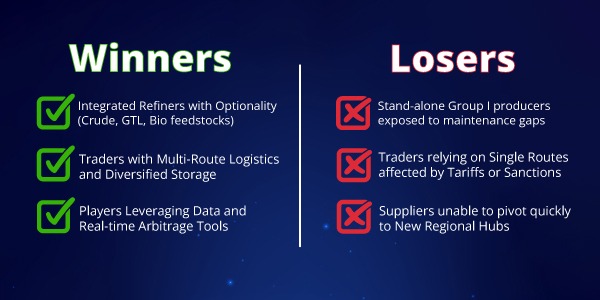Beyond Supply & Demand: Tariffs & Geopolitics Are Rewriting Base Oil Flows


Global trade in 2025 looks very different from the decade before. Tariffs are back, sanctions are widespread, and shipping routes are being reshaped by conflict and regional instability. The average U.S. effective tariff rate has climbed above 10%, reaching levels not seen in decades (WTO 2025).
At the same time, global merchandise trade as a share of GDP continues to fall, signaling a shift away from globalisation toward regionalised, policy-driven trade.
For base oils, a product heavily dependent on cross-border movement of feedstocks, intermediates, and finished grades, these shifts are not abstract, they are structural.
Geopolitical risk indices are at multi-year highs. Governments are leaning on tariffs, industrial policy, and security-driven trade barriers to protect domestic industries.
This results in:
The world is no longer one integrated marketplace, it is a network of competing regional systems.
While trade becomes more complicated, capacity shifts are accelerating.
These supply changes interact directly with tariffs and shipping constraints, shaping price spreads and arbitrage windows.
Sanctions on Russia by the U.S. and EU have sharply reduced traditional Baltic export routes. Approx. 436 kt of Russian base oil that once entered global markets now flows through Turkey, the UAE and the Middle East instead.
This rerouting means:
Meanwhile, rising U.S. tariffs further reshape trade flows, limiting direct imports and encouraging alternative supply paths.
With freight, tariffs, and insurance all rising, regional price differences have widened.
Examples from 2025:
Same product, Same grade but Two different Prices — because logistics and policy are setting the price, not just supply and demand.
Group II:
Group III:
The new base oil environment rewards flexibility — both in sourcing and logistics.

In 2025, advantage doesn’t come from the cheapest product — but from the ability to move it efficiently and strategically.
To stay resilient in a fragmented trade environment, market participants must evolve.
Sourcing from Asia + MENA helps avoid tariff-exposed corridors.
These feedstocks are:
Real-time data and AI analytics helps identify:
Local distributors can help navigate tariff boundaries and ease cross-border flows.
Monitor:
One change in regulation can shift an entire arbitrage opportunity.
Global oil demand is slowing based on the latest IEA outlook — but this slowdown doesn’t mean supply chains are becoming simpler. In fact, they’re becoming more complex and more politically sensitive.
The Middle East remains a critical supply center, and trade patterns across Asia, Europe, and the U.S. are now shaped as much by policy decisions and tariffs as by traditional supply-and-demand fundamentals. In this environment, energy markets are increasingly defined by security considerations, regional alliances, and shifting logistics routes.
Base oils sit right in the middle of this transition — a product class that relies on cross-border movement but must now adapt to a world where trade is more regional, regulatory pressures are higher, and geopolitical risks directly impact pricing and availability.
Tariffs, sanctions, and shifting geopolitics are rewriting the global base oil map.
But while some see fragmentation, strategic players see opportunity:
and demand for cleaner, more flexible feedstocks.